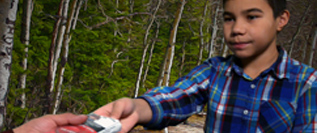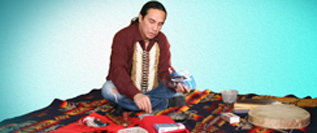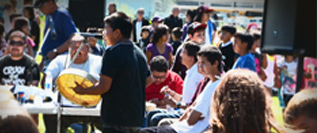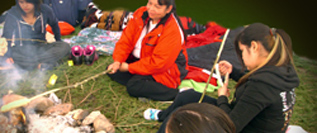Educator Support Resource
Background Support Materials IntroductionThe Community Stewardship resource was collaboratively co-created with community. The intent of this enquiry-based resource is to assist educators and students in gaining knowledge of the community’s local history, historical sites and significant locations as well as the stories associated with them. Educators will be required to seek knowledge, support and assistance from community members, Elders, oskâpewak and traditional Knowledge Keepers in order to ensure that information is appropriate, authentic and accurate. Educators are expected to follow appropriate protocol as identified by the community in all their interactions.
Subject Areas/DisciplinesWhile the resource is intended to support teaching and learning in grades 9 to 12, it can be adapted to all subject areas in all grade levels. It can be taught as an interdisciplinary course, with learning outcomes defined per course or program of study, developed as a Locally Developed Course (refer to guidelines on Locally Developed Courses). The project could also be developed as a Career and Technology Studies (CTS) course or a Career and Technology Foundations (CTF) course. The video clips, activities and lesson plans can be adapted to meet the outcomes or competencies of areas of study such as language arts/English, social studies, science, art, music and media, for example.
Local ProtocolPrior to using this resource, it is advisable that the educator speak to Elders, oskâpewak and traditional Knowledge Keepers from the community to validate the teachings found within the resource and to invite individual Elders, oskâpew or traditional Knowledge Keepers to the first class to provide support and acknowledgement of this curriculum and its intent to convey community knowledge and protocols in relation to community stewardship. Protocol will be demonstrated to the students at this time.
The students and educator are required to participate in the tobacco teachings (see the video clip on tobacco protocol) as identified in the Introductory Unit. Other protocol within the community should be acknowledged and adhered to, based on the situation. Information on specific protocol can be obtained from a local Elder or traditional Knowledge Keeper, who will either share the information and/or advise on an appropriate contact person. (A list of identified community cultural experts, Knowledge Keepers and Elders is provided below and will be updated as required).
Some specific cultural practices identified in the units of study are identified:
SMUDGING is the process of purification and centring one’s body, mind and spirit before continuing with a task, attending a meeting ceremony or just starting one’s day. Various medicines and herbs such as sage, sweetgrass or cedars, as well as others, are burnt to produce the purifying smoke. For more detail and instruction, seek out a local Elder, an oskapew or a traditional Knowledge Keeper.
TOBACCO is the sacred medicine used as an offering primarily to an Elder when asking for advice, support or a blessing.
TOBACCO TIES are tobacco offerings used to ensure that protocol is followed from beginning to end. After the introductory lesson on teaching how to make tobacco ties, it is important that the students understand the process does not end there. The significance between the tobacco offerings is for the students to retain and maintain the knowledge being transferred through spirit. The Elder receiving the tobacco is to show honour and respect to that individual for the sharing with whom they are imparting knowledge.
Steps to making tobacco ties:
- The student smudges in order to purify the mind, body and spirit.
- Next, prepare the tobacco offerings. (Review tobacco ties from Unit 1. Students smudge the tobacco ties before offering them to the Elder.)
- Holding the tobacco tie, the student makes a request to the Elder specifying the matter he or she is seeking advice on. The Elder may take the tobacco and provide the information sought, or the Elder may not accept the tobacco but will give an explanation why he or she doesn’t accept it and the Elder may send you to seek help from another Elder that has that specific information.
Note: Please check with your administration regarding policy on smudging. Some schools may require permission notes signed by a parent or guardian.
There are some community members who may not smudge or accept tobacco as an offering. In this case, it might be acceptable to offer another form of gift instead of tobacco. The students may offer something else, and, basically, anything is open for gifting. It may also be advisable not to have students seek each other’s advice using tobacco ties. It may be more appropriate for students to offer other age-appropriate gifts such as candy.
In teaching this course, the educator must have a person who can authenticate the teachings, either an Elder, oskâpew, traditional Knowledge Keeper or other knowledgeable person from the community. You might even have a resource person within your school that can direct you to someone who can assist. The community resources listing below is also a good place to begin, if you do not already have a community person advising you.
Field TripsEngagement with the community usually requires leaving the school and visiting individuals and sites in and around the local community. To facilitate this, ensure that jurisdictional and school policies and procedures are followed. Prior to heading out on the field trip, review the purpose of the outing, the expected learning and experiential outcomes and other items that are relevant and appropriate to the students and the situation.
Community Resources
Elders, oskâpewak or traditional Knowledge Keepers play a foundational role in the maintenance and continuation of community knowledge. Much of local knowledge does not reside within the pages of text books, video or online resources but in the collective lived and living memory of local community members. This is true across the world. In order to access this valuable storehouse of knowledge and experience, students and educators need to be not only familiar with protocol but be confident in using it in their daily interactions.
Inviting individual Elders, oskâpewak or traditional Knowledge Keepers into the classroom, school or cultural centre for the first time may be daunting. Assistance can be obtained from local individuals in the school or community. Additional information is also available on the Walking Together: First Nations, Metis and Inuit Perspectives in Curriculum website and from pages 71 to 76 of Our Words, Our Ways: Teaching First Nations, Metis and Inuit Learners. The accompanying list of Elders, oskâpewak or traditional Knowledge Keepers is a preview of the expertise that exists within the community.
BCNEA-OPK & Kâpaskwatinâk Community Resource List
| Names | Skills, Abilities, Gifts and Interests | Contact |
|---|---|---|
| Christie Alook | crafts, local history, child-rearing practices | |
| Bert Alook | local history, past band councilor | |
| Christie Auger | craft making: moccasins, knitting, crocheting | |
| Bernard Noskiye | syllabics, local history, legends, storytelling, sap making, hunting, trapping | |
| Clement Auger (Cepwam) | harvesting berries, fungus and plants, hunting | |
| Margaret Rose Auger | brain hide tanning, drying meat, beading, quillwork, fish scales, moose hair tufting | |
| Louis Paul Bigstone | net fishing, dream catchers, wall hangings, paintings | |
| Bertha Manybears | cooks helper | 891-0047 |
| Lillian Manybears | local history, craft making, sap making, traditional preparation of fish, ducks, muskrats, etc. | 891-4054 |
| Mary Cardinal | drying meat and fish, brain hid tanning | |
| Betty Jackson | crafts, bannock on a stick | |
| Francis Cardinal | crafts (miniature moccasins), earrings, mukluks | |
| Elmer Gambler | moose hunting | 891-2388 |
| Maurice Oar | moose hunting | |
| Lawrence Oar | moose hunting | 891-3970 |
| Graham Auger | ducks and rabbits hunting | 773-0775 |
| Paul Gladue Jr. | drying fish and meat, syllabics, local history, storytelling | |
| Clifford Gullion | trapping, preparing skins of beavers and muskrats, storytelling about life on trap line | 891-2000 |
| Ida Houle | traditional preparation of meat, fish, ducks and muskrats | |
| Ronnie Macleod | sleigh and wagon rides | |
| John Felix Auger | net fishing | 891-9226 |
| Phillip Nanemahoo | drum making/drum group | 891-3777 |
| Eli Cardinal | drum making/drum group | 891-8301 |
| Verna Oar/Ray Yellowknee | brain hide tanning, drying meat, traditional food preparation | 891-3389 |
| Evelyn Okemow | fish filleting, traditional meat preparation | |
| Linda Beaver | caterer (traditional foods) | 891-2552 |
| Yvonne Alook | caterer (traditional foods) | |
| Sandra Cardinal | caterer (contemporary and traditional foods) | 891-2035 |
| Virginia Rathbone | local history, child-rearing practices, drying and preparation of fish and meat | 891-3748 |
| Kathy Thunder | local history, child-rearing practices, drying fish and meat | 891-3295 |
| George Thunder | moose hunting, traditional preparation of meat, fish and ducks | |
| Cecile Yellowknee | brain hide tanning, caterer (traditional feast) | |
| William Yellowknee | brain hide tanning, preparation of meat | |
| Nora Yellowknee-Sawan | local history, child-rearing practices, preparation of meat, cook | 891-3672 |
| Alvin Young | net fishing, oskâpew | |
| Leonard Young | local history, past band chief and councilor | |
| Vina Young | local history, hide tanning, child-rearing practices | 891-2250 |
| Mabel Yellowknee | local history, crafts, child-rearing practices, preparation of meat | |
| CEREMONIAL PEOPLE | ||
| Albert Yellowknee | traditional ceremonies | 891-9142 |
| Gerald Auger | oskâpew, actor, traditional information, practices and value system | |
| Roger Cardinal | oskâpew | |
| Mike Beaver | cultural heritage, traditional information, practices and value system, past chief and councilor, pipe carrier, lodge holder, wihkohkew | |
| John Bigstone | pipe carrier | |
| Lillian Bigstone | pipe carrier | |
| Lorraine Cardinal | legend storyteller, women’s ceremonial holder and teachings | 331-2914 (Calling Lake) |
| Julian Ribbonleg | drummer, singer | 780-659-3893 |
| LIMITED CAPACITY/MOBILITY | ||
| Denys Auger | cultural heritage, traditional information, ceremonial practices, value system, pipe carrier, lodge holder, past band councilor (wheel chair) | |
| Rita Auger | crafts, local history, child-rearing practices, cultural heritage, past band councilor (wheel chair) | |
| John D. Nanemahoo | storytelling, local history, cultural heritage, hunting, traditional dancing and singing (under care and watch) | |
| Marina Alook | child-rearing practices, family history, drying meat and fish (wheel chair) | |
| Donald Yellowknee | storytelling, local history, hunting (wheel chair) | |
Contact local school staff to learn about previous projects that have been undertaken in the community.
Contact the school or jurisdiction liaison workers for assistance in contacting knowledgably community members.
Do not forget that good relationships with your students, their parents or guardians and community members are the best ways to learn about and gain access to community resources.
Published ResourcesBigstone Cree Nation and Metis People of Kituskeenow. 1999. Kituskeenow: Cultural Land-use and Occupancy Study. Calgary: Arctic Institute of North America of the University of Calgary. (ISBN: 0-919034-89-6)
Garvin, Terry. 1992. Bush Land People. Calgary: Arctic Institute of North America of the University of Calgary. (ISBN: 0919034691 / 0-919034-69-1, available through www.abebook.ca)
Professional Development
Contact your local Alberta Profession Development Consortia representative for more information.
Internet Resources and Supports
- Our Words, Our Ways: Teaching First Nations, Metis and Inuit Learners
- Welcoming Elders, pages 71 to 74
- Awareness of Community Protocols, pages 75 and 76
- Guidelines for Talking Circles, page 163
- Walking Together: First Nations, Metis and Inuit Perspectives in Curriculum
- An introduction to protocol is contained within FNMI Worldviews. Click on “Beginning Together.”
Maps
- Google Maps: Wabasca and Desmarais
- MD of Opportunity No. 17: Area Maps
- Government of Canada: The Atlas of Canada - Toporama (This interactive map requires some searching to get the correct detail and resolution, but it is printable.)
- Fish and Wildlife Internet Mapping Tool (This interactive map requires some searching to get the correct detail and resolution, but it is printable.)
A forestry map of Bigstone Cree Nation traditional territory can be obtained at the Bigstone Cree Nation Administration office.
Language and Culture Sites
Two Internet websites that feature syllabics used in the Cree language are Tavultesoft and Online Cree Dictionary.
The Gift of Language and Culture Project and Four Directions Teachings websites both offer resources and teaching tools.
Note: Refer to local authorities first to learn more about regional variations and writing systems for Cree language and culture.




